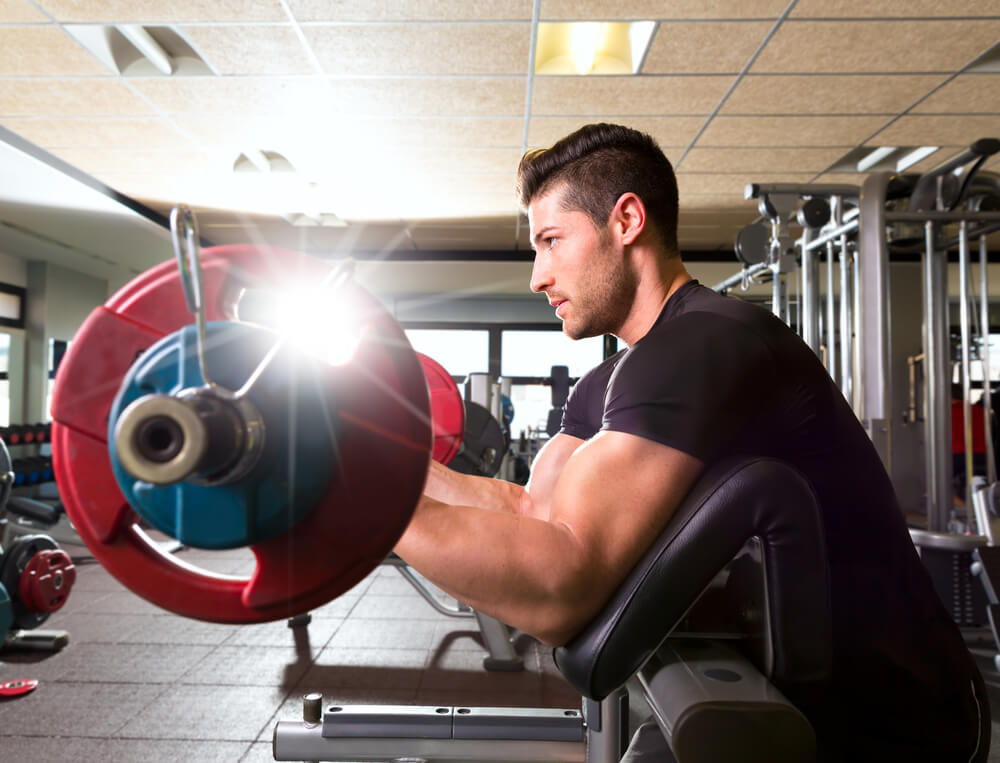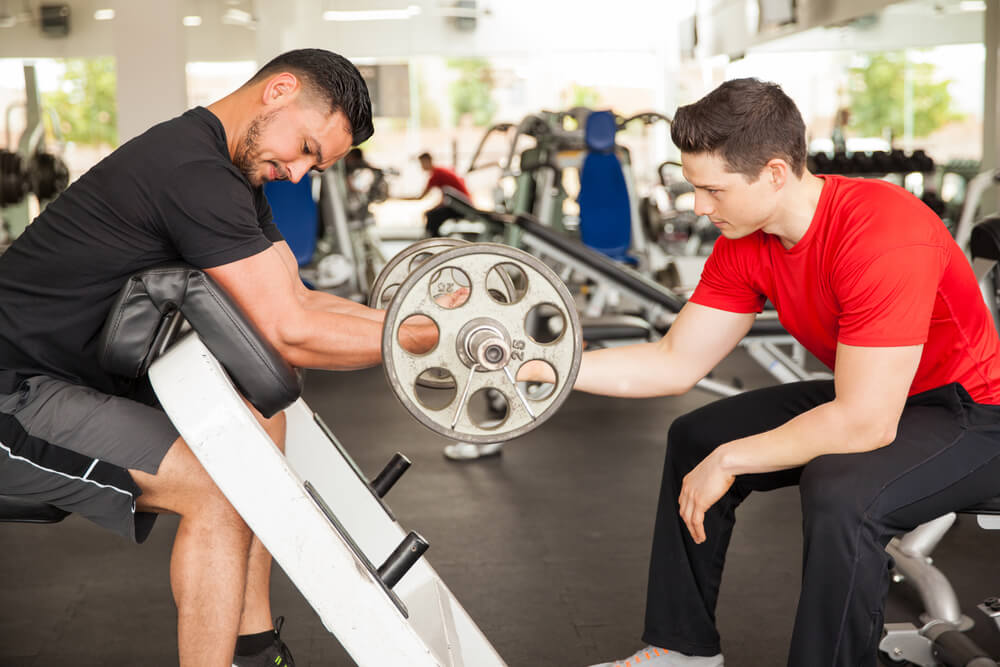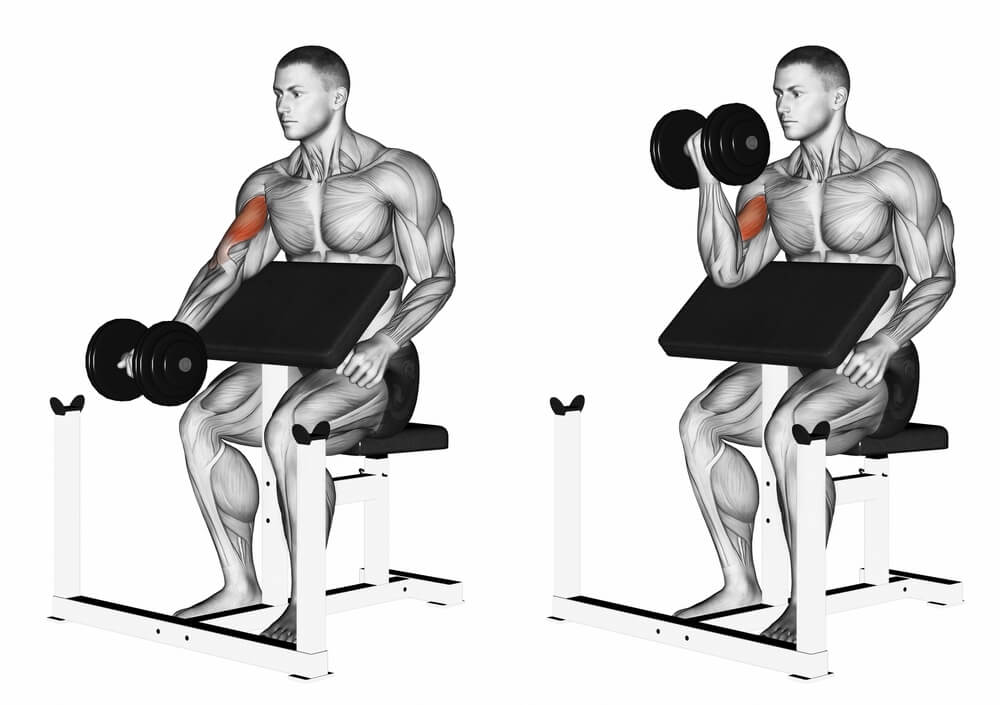Your biceps, arms, guns or whatever else you want to call them is the main focal point for many guys at the gym. They want massive arms that rip t-shirt seems.
Of course, you can always spot the guys who only really work their biceps a mile away. They have no pectoral muscles and their shoulders are more than disappointing. Don’t be that guy (or girl, if you’re going for bigger muscles).
You should target each area of your body so you have evenly defined muscles throughout. Besides, there will be some people you want to attract who are into arms, while others are into backs, shoulders, chests, butts and so on.
Thankfully, targeting your arms isn’t difficult.
There are several great bicep exercises designed to really tear up the muscle tissue in your arms, allowing you to grow for massive gains.
The preacher curl is one such exercise.
However, if you’re going to do it you need to do it right.
Otherwise, you’re just cheating yourself, wasting your time and killing your potential gains. Let us show you how to perform the preacher curl for the best pump and the best size and strength improvements possible.
Keep reading to find out more!
The Bicep Heads
Before diving into the actual move, let’s get down and talk about your bicep.
When you flex, look at it in the mirror or simply inspect the muscle in general, it looks like one massive rock of muscle.
In a way this is true, but in all actuality, the bicep is made up of two “heads.”
There is the inner head and the outer head. If you flex and look at your bicep, you’ll see the muscle is a bit longer where it points to your elbow joint (you can see this depending on body fat percentage, so if you can’t just take our word for it). This point in is your inner head. The rest of the muscle to the outside of your arm is the outer head of the bicep.
So why do the heads of your bicep matter?
For starters, because the muscle is broken down into two heads, you need to lift slightly differently in order to hit both heads. The way you lift can also play an impact on the size of your bicep. The inner head comes to a taller peak, so by targeting the inner head of your bicep, you’ll increase the height of your bicep. The outer head, on the other hand, is the bulkier of the two, so when you target this area primarily you’ll increase the width of your bicep.
The way you lift can also play an impact on the size of your bicep. The inner head comes to a taller peak, so by targeting the inner head of your bicep, you’ll increase the height of your bicep. The outer head, on the other hand, is the bulkier of the two, so when you target this area primarily you’ll increase the width of your bicep for the largest biceps.
Due to this, if you want to increase the height of your bicep, you’ll target the inner head, while you’ll aim for the outer head if you want a wider, thicker bicep.
How You Hit the Two Heads
Do you remember the old Pizza Hut commercials with Deion Sanders (back when he played) along with Jerry Jones?
During the commercial, they asked Deion if he played offense or defense, to which he replied “both.”
Someone would ask if you want cheese on the pizza or in the crust, someone would say “both,” and then Jerry Jones asked Deion if, for his next contract, he wanted $10 or $15 million and he would say, in a very Deion sort of way, “both.” Long story short, why settle for one or the other when you can have both.
The same is true with your bicep heads.
Why settle for just taller or wider biceps when you can have both?
You just need to know how to hit both the inner and outer heads. Thankfully, you can do both with the preacher curl.
Hitting your different heads really comes down to how you curl. It’s also why you may have found one head is developing more than the other (now that you know the inner head is height and the outer head is width).
The closer you hold your arms into your body when you curl, the more you target your inner head. If you have a wider grip (such as on a barbell), the more you’ll target your outer head. It is why if you ever perform a cross body curl (your right arm but you curl the weight from your left side, across your chest) you can feel a substantial amount of tension on the inside of your arm. It is also what makes the preacher’s curl such an excellent move for size and strength gains.
We’ll get into performing the preacher’s curl in a moment, but as you are resting your elbow on a surface, you can alter the direction for which you curl up, giving you almost total control as to what head you hit.
You will always cause tension in both heads during a curl, but by shifting more tension to one head over the other, you can improve strength gains much faster in the given head.
The Preacher’s Curl
Alright, let’s jog your memory in case you’re not exactly sure which one the preacher’s curl is (after all, there are so many curls to keep track of).
With the preacher’s curl, there is a specially designed armrest and seat in front of it. The armrest, which is positioned at around a 45-degree angle, allows you to place your elbows on the pad as you curl up.
The purpose of this curl is to isolate your biceps. Because you are sitting and your elbows are pressed down on a stationary object, your back does not engage with the curl. Many people, whether they realize it or not, cheat while curling weight as their back helps assist with the lift.
This removes tension from the bicep, reducing your possible gain. While there are other excellent curl exercises that target your bicep in an isolated manner, this is one of the best.
It almost exclusively hits the bicep, although you can extract some triceps training from it based on how you lower the weight down.
How to Perform The Preacher Curl Workouts
We’ll look at performing a traditional preacher’s curl and then dive into some form variations and other recommendations.
A traditional preacher curl stats out at the elbow rest station. If you don’t have this around it is alright, you can take an adjustable bench and put the backrest at a 45-degree angle (you’ll have to go one arm at a time but this works just as well, if not better). At the station, you’ll have a curl barbell loaded with weight.
Take hold of the barbell (remember, the closer the grip the more tension you placed on the inner heads and the further out the grip the more tension you place on the outer heads) and curl up. Breathe out as you curl up. Hold the curl and squeeze your bicep at peak tension, then lower the weight slowly. By lowering the weight slowly you’ll also hit your triceps.
This is one rep…
There is one technique form we want to go over and it has to do with your wrists. Normally when you curl your wrists are going to be tilted toward your bicep (as if you’re flexing in the mirror). This places more tension on your wrists and actually opens you up for wrist pain. It also reduces some of the tension placed on your bicep because your wrist is involved. Instead, you need to take your wrist out of the equation (doing so will help substantially if you have wrist pain).
How do you take your wrist out of the equation?
Hold your hand out, as if you’re a waiter holding a tray. How to clench down as if you’re holding a barbell.
Can you feel the difference?
It keeps your wrist along the same line as your arm, reducing the amount of tension placed on the wrist. When you curl up in this position you’ll also feel more tension in your bicep now that your wrist is not taking the tension away.
It’s a slight adjustment that may take some time to get used to (just because you’ve probably been doing curls with the wrist curved toward your bicep for as long as you can remember), but it will help increase your gains and reduce wrist pain (SN, 2015).
Preacher Curl Variations
The traditional preacher curl is done with the curl barbell.
However, there are other options (some of which are better). Let’s first start with the one you should skip out of. The preacher curl machine. 99 out of 100 times we will always tell you to use the real weight version instead of a machine version. Exercises performed with the cable machine is a bit different as you’re still in charge of the range of motion, but for the most part, you should always look away from the machine.
This is true with the preacher curl machine.
The problem with this is you won’t hit any of the stabilizer muscles. There is a muscle directly underneath the bicep on the outer portion of the arm. This is the brachialis. It basically is on top of your bone and directly under the bicep.
By targeting this muscle (which is better done with a move such as hammer curls), you’ll strengthen this small muscle and increase its size. The importance of this is by increasing the size of the brachialis, the muscle pushes up on the bicep, which in turn gives you huge biceps.
The traditional preacher curl does this as the brachialis works as a stabilizer muscle. The machine does not use this muscle, so you miss out. You also can’t adjust your curl motion or grip placement, which means you can’t alter which head you’re hitting.
You may find it better to use a dumbbell instead of a barbell.
With the dumbbell, you can alter your curl motion. For starters, you can increase or decrease the grip width in order to better target your bicep heads. You can also perform a preacher curl across your body to really hit the inner head. This is not a move you can do with the barbell.
It will take you longer to complete the sets, but it is well worth it.
Reps For Gains
Now that you know how to better hit your bicep heads (knowledge you can use on all your future curl exercises), you need to know how to rep for your gains.
For starters, a preacher curl exercise circuit should be towards the back half of your arms workout day. You will have other moves that better hit both your biceps and triceps, as well as forearms and shoulders.
Those moves should receive more of your early attention (and energy).
As a back-half arm day workout, you’re going to run through the sets at least two times. You can go three times through if you’d like. If you’re using a variation of the curl, such as the cross-body preacher’s curl, go ahead and do it three times as you’re probably hitting the inner head in ways none of the other lifts have done.
However, if you’re doing it straight up, two is perfectly fine when combined with all your other arm day lifts.
In terms of the reps per set, it depends on what you’re going for.
Do you want to hit your arms in order to increase strength?
If so, shoot four around four reps per set. It needs to be challenging though. If you can squeeze out even five reps it means the weight is too light. If you do max out at four, increase the weight for the second time through.
Now, if you are aiming for size, target eight to 12 reps. If you can’t make eight you are using too much weight, if you can go over 12 you need more. The good thing about a big arm workout is you can complete your sets to failure without worrying about a bar crushing your chest or crippling your legs.
Conclusion
The preacher curl (or preacher’s curl, depending on who you talk to) is a great bicep workout as it allows you to target and isolate the muscle. By shifting how you lift you can better hit the inside or outside heads of your bicep. While not the most important arm exercise you’ll do during arm day, it is an excellent addition you should include.
-Terry Asher
Terry Asher
Latest posts by Terry Asher (see all)
- Better Family – Product Review Liquid Daily 2 oz - Dec 16, 2024
- Post-Workout Recovery: The Key to Optimal Performance - Nov 25, 2024
- Pre-Workout Supplements – Everything You Need To Know - Nov 18, 2024














Never worked for me-
Great article!
Thank you, Shannan 🙂
-Terry Asher
[…] curl is a stable lift that is great for builing lean […]
[…] gyms will have a spider curl bench but if you don’t have one, you can also use a preacher curl […]
[…] gyms will have a spider curl bench but if you don’t have one, you can also use a preacher curl […]